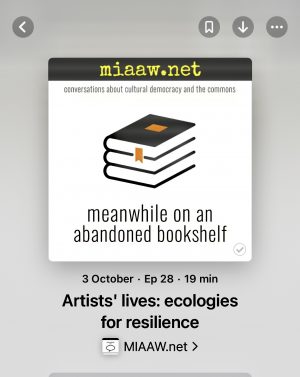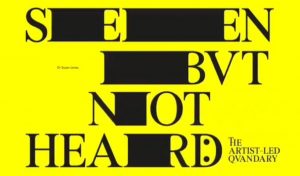Owen Kelly critiques Artists’ lives: ecologies for resilience in a MIAAW podcast. In particular, he considers the efficacy and social resonance of the study’s research methodology which — unusually for the arts — is qualitative and longitudinal. He judges its value as provision of a unique and detailed examination of the kind of lives artists live when culture is seen politically as an industry rather than as a social responsibility.
Read “Artists' lives - the arts policy fallacy” in full
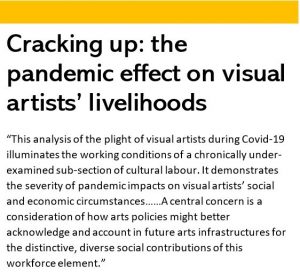
Analysis of the plight of visual artists during Covid-19 illuminates the working conditions of a chronically under-examined sub-section of cultural labour. It demonstrates the severity of pandemic impacts on visual artists’ social and economic circumstances, including from inappropriate criteria for accessing government and Arts Council England emergency measures. A central concern is consideration of how arts policies might better acknowledge and account in future arts infrastructures for the distinctive, diverse social contributions of this workforce element. The commentary reveals a stark contrast between ambitions at national and local levels about what artists and the arts are for, and where and how arts policy should be made and implemented. It evidences an emerging grassroots appetite for a dramatic shift from current hierarchical patterns driven by national imperatives to nuanced, localised infrastructures that can ensure artists’ multiple talents and assets contribute fully to social and economic change for the better within communities.
Read “Cracking up: the pandemic effect on visual artists’ livelihoods” in full
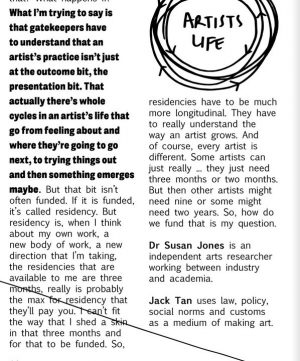
Jack Ky Tan extract from Desire Lines publication, Proforma 2021
A public conversation in November 2021 commissioned by Proforma for Desire Lines and facilitated by Chris Bailkoski brought together Jack Ky Tan and Susan Jones. Read extracts from this discussion that explored how misconceptions and imbalances in the arts ecology limit artists’ status, pay and livelihood chances and what needs to happen to ensure artists can live a flourishing life through art practices over a life cycle.
Read “A flourishing life” in full
Effective strategies for retaining the artist-led as a vital ingredient in social and arts well-being in future involves artists seeking out allies and synergies beyond the restrictive hierarchies of the contemporary visual arts.
Read “Seen but not heard: the artist-led quandary” in full

Reset or rewild masthead, Corridor 8
Text exploring the impacts of Covid-19 on artists’ livelihoods and the divergent perspectives on creating a healthier, more productive and inclusive arts ecology in future.
Read “Reset or rewild” in full
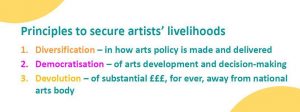
This submission was made in June 2020 to the DCMS Committee considering the impact of Covid-19 on any sectors under the Department for Digital, Culture, Media and Sport’s remit. It contextualises artists’ livelihood frameworks and sectoral artistic and economic opportunity, highlighting key challenges and barriers faced by this particular sub-section of the creative industries. It evidences the distinctive limitations of short-term emergency measures from Government and the Arts Council to alleviate immediate Covid19 circumstances. Although arts policy marginalised support for artists’ livelihoods after the 2008 recession, the examples of artists’ individualised resilience strategies illustrate the scope and value of supportive interventions by policy relevant to forecasting new strategies for ameliorating the medium and longer-term effects of the pandemic on this vital, distinctive creative industries sub-section. The rationale for structural changes in implementation of arts policy and funding is to remove known barriers and better in future capture and amplify the assets that artists create for their own resilience and bring to social well-being over a life-cycle.
Read “Support for artists' livelihoods in a Covid-19 world” in full

Artists emergency hashtag
“We must see the cultural ecosystem in which every person, every organisation, every cultural expression, has a legitimate place.” Francois Matarasso, Let’s use this breathing space wisely, 25 March 2020
Strategic arts policy funding interventions premised on equality and co-operation are key to sustaining visual artists’ livelihoods over a life-cycle. This text in the Covid19 portfolio combines secondary data analysis with cross-references to prior and new research to offer six reference points for the economic value of artists’ practices within the arts and creative industries including indication of their income sources in broad terms. It concludes with an argument for vital new structural arts policy and advocacy measures to ensure that many visual artists – not just a few — survive through the immediate period of the Covid19 emergency and during what is likely to be a sustained period of economic recession beyond.
Read “Artists’ emergency: arts policy’s role in the future of artists’ livelihoods” in full
This paper combines arguments first presented by Susan Jones at an engage annual conference in which she questioned the efficacy of our institutionally-driven visual arts ecology with new research and enquiry into future cultural, digital and social environments for the arts. It calls for adoption of a more open, imaginative, lateral, collaborative and responsive approaches to creating cultural value, premised on building relationships and rapport with the different kinds and bandwidths of audiences and with the enablers and the makers of art. Links updated 17/05/2018
Read “Creativity at the heart: the holistic approach” in full
